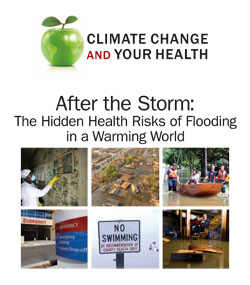After the Storm: The Hidden Health Risks of Flooding in a Warming World
 Extreme precipitation and flooding, likely on the rise in a warming world, carry significant and often hidden health risks, according to a report, “After the Storm: The Hidden Health Risks of Flooding in a Warming World,” released today by the Union of Concerned Scientists (UCS).
Extreme precipitation and flooding, likely on the rise in a warming world, carry significant and often hidden health risks, according to a report, “After the Storm: The Hidden Health Risks of Flooding in a Warming World,” released today by the Union of Concerned Scientists (UCS).“Damage from floods is typically measured in terms of lives lost and the cost of damage to buildings and infrastructure,” said Liz Perera, UCS public health analyst and one of the report’s co-authors. “But what are often overlooked are the potentially costly public health impacts.”
The report calls attention to these impacts by listing the top five health risks of extreme precipitation and flooding:
Drowning while driving: Almost half of 2010 flood fatalities involved people who drowned while attempting to drive through floodwaters. Only 18 inches of water can lift a car or SUV; once buoyant, the water will easily push the vehicle sideway. Most vehicles then tend to roll over, trapping those inside.
Waterborne diseases contaminating drinking water: Extreme precipitation and flooding can sometimes overwhelm drinking water infrastructure and wells, which reduces or prevents water purification. Over half of all waterborne disease outbreaks in the United States occur in the aftermath of heavy rain.
Sewage back-up in plumbing or basements: Flooding can cause local sewage lines and septic tanks to overflow, sometimes resulting in sewage backing up into people’s residences.
Bacteria, sewage, and other contaminants in waterways: During flooding, untreated sewage, pesticides, and street contaminants (motor oil, dog excrement, etc.) can flow into local rivers, lakes, ponds, and even ocean beaches.
Mold and dangerous indoor air quality: Water intrusion anywhere in a building can cause toxic mold to grow in ceilings, walls, or insulation.
“Over half of all outbreaks of waterborne diseases in the U.S. occur in the aftermath of heavy rains,” said Perera. “Health risks will likely increase as extreme rainfall events are projected to become more common in a warming world.”
Heavy rains can contaminate drinking and recreational water with sewage, petroleum products, pesticides, herbicides, and waste from farm animals, wildlife and pets. Floodwaters may contain more than 100 types of disease-causing bacteria, viruses and parasites.
“We think of waterborne illnesses as a problem in developing countries, but it’s a very real public health issue here in the U.S.,” said Dr. Marc Gorelick, division chief of pediatric emergency room medicine at Children’s Hospital of Wisconsin, in Milwaukee. “Climate change, because it likely causes heavier storms, could threaten our already vulnerable water supply and lead to more cases of gastrointestinal illness.”
Gorelick conducted a study which found that between 2002 and 2007, there was an 11 percent increase in gastrointestinal cases at Children’s Hospital within four days of heavy rains.
The UCS report also points out that flooded homes and buildings create a breeding ground for mold, which can cause debilitating respiratory and neurological problems. Mental health problems also tend to increase in the wake of extreme weather disasters. These health problems can persist long after flood waters have receded.
Extreme weather events, such as heavy rains, are also creating challenges for waste water and water treatment plants.
“Like many older cities, heavy precipitation can put a strain on New York City’s infrastructure,” said Angela Licata, deputy commissioner for sustainability at the New York City Department of Environmental Protection. “We are continually innovating to meet that challenge, while maintaining and improving essential services.”
Other factors that affect flooding risks include where people live, how land is developed and the investments made in building resilience.
You can return to the main Market News page, or press the Back button on your browser.

